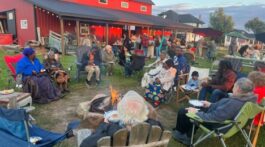What do Adventist never-married, divorced, widowed, celibate-by-choice, or married-to-unbeliever adults have in common? In the pew, they are likely to be pooled into an unofficial social category called “singles.”
Who are single people?
These individuals may range in age from late-teens to post-retired. They may be single parents, or grandparents raising children alone. Unemployed or top-tier earners also comprise this group. Some are unmarried couples, or those who grieve a divorce or a spouse lost in death. Some choose a celibate lifestyle due to health or gender identification issues. Others may see a loving marriage relationship in their future. Additionally, church members who are married to a non-attending member or to an unbeliever might sometimes be categorized as singles within a congregation.
Perhaps he is a child or relative of a minister or other church leader. She may be the only Adventist in her family of origin. He may be a relative of Adventists in another community. She may sacrifice dearly to be able to attend your church on Sabbath morning, or he may attend church only to fulfill an obligation made to others who care about him.
He may be lonely and depressed in need of healing, or she may be bubbling over with energy, love of her Savior, enthusiasm for her faith, and looking for an outlet for her strengths and passions. He may be longing for a friendly home-cooked meal, or she could just need some type of permission to plan a party or event to provide fellowship. He may have relocated to your community for employment, or recently graduated from academy or college. These and many more scenarios comprise a collage of faces in this potentially large and specific group of attendees within your Adventist church family.
Perception of singles
Let’s face it. In church, perhaps more than in general society, it seems likely for singles to be more “invisible” than married people are. Why? One could speculate a misconception that being unmarried and “footloose and fancy free” makes them less reliable members. Or protective spouses could be fostering “arms-length” interactions with singles (for whatever imagined reasons!). Could it be that a “Mr. or Mrs.” in front of someone’s name indicates a preferred stable and responsible status? (If employee résumés are sometimes misjudged on these criteria, it is believable that it could carry over to the church!)
Of course, these judgments are not fair. After all, Paul the apostle asserts that either marriage or singleness is not for everyone. For those who accept God’s guidance in this regard, singleness is not a problem, but can be “a gift.”1 A list of outstanding Bible singles might include, among others, icons like Jesus, Mary Magdalene, Martha, Lazarus, Miriam, Elijah, Jeremiah, Lydia, and Paul!
Quandary or opportunity?
Adventists share this scenario with other denominational churches as well. There are more married people in church than singles. According to a recent Barna study, 23% of regular church-goers are single. Compare this with studies reporting that more than half the national average (54%) of people ages 18-49 are single.2 So, doesn’t this mean that more than half of your church should be single people—instead of one-fourth?
Ministry to singles of every diverse description shares similar as well as specific needs. Yet singles “get” each other in their empathy, and need each other for the special fellowship that all Christians are called to provide to each other on our spiritual journeys.
Capacitated!
In recent years Adventist Church leadership have been troubled by the exiting and resulting absence of young adults (who, by the way, are a lot of singles!) from the general membership and participation in church life in many societies around the world, especially here in the West. An overwhelming percentage of solutions presented emphasize what local church leadership can do to recruit and retain singles. I’m proposing here an alternate emphasis: single people can best do the recruiting and retaining themselves! Consider this quote:
“Never doubt that a small group of thoughtful, committed citizens can change the world.Indeed, it is the only thing that ever has.”
— Margaret Mead, anthropologist
What a novel idea! Wasn’t it a small group of singles who were instrumental in beginning the Seventh-day Adventist Church? Of course, they were delegated and empowered by God. Do you think that, if given the authority and permission (note these important key words!) by their church, single Adventists could actually be able to take on the entire mission of recruitment, nurture, and retention in their ministry to singles –on their own?
- Singles are attracted to other singles. (having complete autonomy, as opposed to being “half of a couple”)
- Singles share a unique understanding of the time and social availability of other singles. (being able to have a Saturday night event that goes past midnight, for example)
- Singles possess leadership qualities, too! (duh!)
- Some things may make better sense to singles than to others. (such as mixing a Bible study time followed by a social setting)
Permission, please
So should singles seize the initiative to take on this focused ministry all on their own? Perhaps not, and here’s why: church congregations usually have a set protocol regarding activities in the interest of keeping order. Some are “unspoken” rules that are often necessary to be sure activities meet the profile of the church’s mission.
For starters, singles could approach local church leadership regarding permission. Leadership might follow some supportive simple ideas that could include:
- Appoint at least 2 or 3 responsible singles as a nucleus team.
- Authorize this singles group to act as a function of an already official church entity (Sabbath School? Social Committee? Lay Evangelism? etc.), included into their structural network.
- Authorize this singles group to raise their own funding, perhaps processed through the church treasury.
- Authorize this singles group to recruit and retain other singles with the church’s blessing and support (church facilities use, general acknowledgement, bulletin announcements, etc.)
- Provide accountability by requesting a regular report to the church communications official for inclusion in a newsletter or other information source.
- And then . . . . just let them go!!!
Why? Because Romans 12:4:6 (KJV) tells us: “For as we have many members in one body, and all members have not the same office: So we, being many, are one body in Christ, and everyone members one of another. Having then gifts differing according to the grace that is given to us.” Yes, the Apostle Paul was quite right in stating that singleness can be, indeed, a gift!1
11 Corinthians 7:7 “For I would that all men were even as I myself. But every man hath his proper gift of God, one after this manner, and another after that.”
2Barna, G. (2018). Barna trends: Your comprehensive guide to the latest cultural, religious, and political trends.
Through the fabric of Lucy Cisneros’ life—family, ministry, academics, music, employment, volunteerism, hobbies—run golden threads weaving a personal portrait of her passionate devotion to her God.










